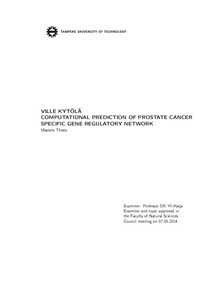Computational Prediction of Prostate Cancer Specific Gene Regulatory Network
Kytölä, Ville (2014)
Kytölä, Ville
2014
Biotekniikan koulutusohjelma
Tieto- ja sähkötekniikan tiedekunta - Faculty of Computing and Electrical Engineering
This publication is copyrighted. You may download, display and print it for Your own personal use. Commercial use is prohibited.
Hyväksymispäivämäärä
2014-06-04
Julkaisun pysyvä osoite on
https://urn.fi/URN:NBN:fi:tty-201406231315
https://urn.fi/URN:NBN:fi:tty-201406231315
Tiivistelmä
Prostate cancer is a highly common disease in the Western countries with its prevalence growing every year with the standard of living and life expectancy. Despite extensive studies prostate cancer presents still considerable challenges to patient care, scientists and societies. As still no curing treatment exists for the recurrent form of the disease prostate cancer is likely to remain an intensive subject for study also in the future.
Even though numerous studies exists that try to characterize individual components and pathways of regulation, no real attempts have been made to characterize the regulation profile of prostate cancer in a genome-wide level. This thesis forms a basis for this ambitious feat by using computational methods in transcription factor mediated regulation prediction and network inference. DNase I hypersensitivity guided genome scanning with transcription factor specific position weight matrices is performed in several manners, producing a catalogue of putative regulation connections in LNCaP cells.
The predicted connections are subjected to thorough evaluation and several applications of the first method are presented, forming a strong set of basic guidelines for computational prediction based regulome assembly for future studies. In addition, as a further application gene expression data is applied to selectively extract a subnetwork of regulation present exclusively in the studied LNCaP cells. As a conclusion the genome-wide computational regulome assembly is presented as a functional but challenged approach with enormous potential due to its possible applications as cell type or disease specific network profiling tool.
Even though numerous studies exists that try to characterize individual components and pathways of regulation, no real attempts have been made to characterize the regulation profile of prostate cancer in a genome-wide level. This thesis forms a basis for this ambitious feat by using computational methods in transcription factor mediated regulation prediction and network inference. DNase I hypersensitivity guided genome scanning with transcription factor specific position weight matrices is performed in several manners, producing a catalogue of putative regulation connections in LNCaP cells.
The predicted connections are subjected to thorough evaluation and several applications of the first method are presented, forming a strong set of basic guidelines for computational prediction based regulome assembly for future studies. In addition, as a further application gene expression data is applied to selectively extract a subnetwork of regulation present exclusively in the studied LNCaP cells. As a conclusion the genome-wide computational regulome assembly is presented as a functional but challenged approach with enormous potential due to its possible applications as cell type or disease specific network profiling tool.
